Welcome to the first part of my Dredge primer! Today, I’ll talk about maindeck card choices – what are the main goals of the deck, why is it built this way, not another, and what are the basic interactions between the cards.
If you want to find more Dredge content, including a detailed sideboard guide, check out this link.
If you are not familiar with currently played Dredge lists, you can find an example here.
Introduction
Dredge is an aggro-combo deck that abuses the ‘Dredge’ mechanic to create card and tempo advantage. The more cards we flip from our library to the graveyard, the more threats we can present, so in practice, the main goal is to mill as many cards as possible. Deck has two main ways to pressure opponents. The first one is aggro with recursive creatures – Prized Amalgam, Silversmote Ghoul, Narcomoeba, and Ox of Agonas. The second one is Burn in the form of Creeping Chill and (sometimes) Conflagrate. In tempo games, Dredge tries to set up a big board quickly and win before the opponent can deal with every threat or execute their game-winning combo. It doesn’t matter that our creatures aren’t the most powerful on their own. What matters is that you often go so wide that it’s hard to deal with everything on time. In some matchups Dredge can also act as a value, card advantage-oriented strategy, which can overwhelm the opponent with generated resources. It’s also possible to act as a control deck. For example, it works quite well in some creature matchups thanks to Conflagrate, Darkblast, sideboard creature removal, and continuous blockers. This type of play is less and less seen though.
While the deck is very linear, it’s not without its challenges: sequencing your spells can be tricky. Also, playing around graveyard hate and soft answers like countermagic or discard is oftentimes tough. It’s easy to flip cards and see what happens, but the real challenge starts when you want to play the deck optimally. Timing, decision-making process based on flipped cards, fighting through grave hate cards, etc. took me years to master. And thanks to my guides, I hope this process will be easier for you.
Dredge in 2024 versus old builds. Why was the change needed?
It all started in 2016 when Prized Amalgam and Cathartic Reunion got printed. Dredge was a very different deck then. Life from the Loam was a centrepiece of the archetype – it helped enable huge Conflagrates as well as endless Bloodghasts triggers. That version was very flexible and could act as a tempo, midrange, or even a control deck, while still being capable of combo draws. The deck was so busted compared to the rest of the metagame that Wizards had to weaken it a bit, so they decided to re-ban Golgari Grave-Troll.
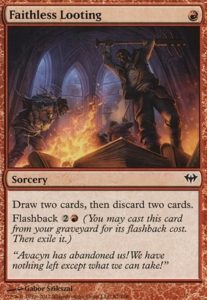
The deck survived and was still playable thanks to Golgari Thug. But it wasn’t as stable and fast, so it was slowly being outclassed by other, new strategies. In 2018, I was even close to abandoning the deck, but the printing of Creeping Chill got the power boost Dredge needed. With the printing of Modern Horizons we got Hogaak, Arisen Necropolis, but it got banned two months later, alongside Faithless Looting. And that was the end of major changes for the archetype back then. Sure, we got Ox of Agonas in January 2020, but compared to what the rest of the format got (Uro, Titan of Nature’s Wrath for example), it wasn’t spectacular. Still, the card let Dredge survive the rise of the power level of the average Modern deck, even if it worked horribly with Life from the Loam + Conflagrate engine. But after the biggest jump in power level in the format’s history – the release of Modern Horizons 2, Ox alone wasn’t enough. Other decks were simply faster, more stable, and less vulnerable to hate. Graveyard hate cards were overpowered compared to what graveyard decks could present. They either cost zero mana (like Endurance), or the game ended when it entered the battlefield (Dauthi Voidwalker or Sanctifier en-Vec). Comparably, the traditional build of Dredge was still quite slow, fragile in the face of hate and had a higher fail rate than other options available in the format. There simply weren’t enough arguments to play it in its current form. When old ideas were no longer good enough, the only hope for the archetype was to be rebuilt from scratch. The flexibility of game plans turned out to not be impactful enough to stick to it. Because of how the deck works, we couldn’t make the deck much more stable – the variance of what we flip in the top twenty cards of the library will always lead to some broken starts and fail rates as well. The only thing that could be upgraded was how fast we can present meaningful board states. That’s why the current build of Dredge is focused on presenting as much power on turns two and three as possible. The deck relies more on ‘draw three’ effects and a curve of turn one enabler, turn two Cathartic Reunion//Thrilling Discovery and turn three escaping Ox of Agonas. During this process, we try to flip as many payoff creatures that can return to the battlefield on the same turn we cast our draw spell. The newest addition threat-wise was Silversmote Ghoul – it’s useful thanks to its synergy with Creeping Chill. Bloodghast got cut because it can’t return to the battlefield after a turn two Reunion. Also, it required lands to trigger it and without Life from the Loam, it’s not trivial to get those consistently. Speaking of Loam, it’s not worth spending a turn on future land drops when the alternative is setting up creatures to pressure the opponent’s life total. The manabase was rebuilt to better reflect those new mana requirements, and will be covered in detail later on.
Why should you play Dredge?
If you want to play Dredge because you think it’s the best deck in the format, I have bad news for you. It’s not 2016 anymore when doing any type of broken stuff was enough to win tournaments. Now everyone does something at least a bit unfair to punish opponents’ worse draws. Another problem is that graveyard hate options are much better compared to graveyard threats. That’s why if Dredge is close to becoming a tier one deck, it will instantly be hated out. Our fate is to be a solid tier two strategy at best, mostly when there isn’t that much graveyard hate and there are enough good matchups around.
Even if Dredge will probably never be a tier one again, it offers a unique experience and play patterns that can’t be performed by any other deck in the format. Its high-variance nature is also something that can be seen as a reason to play the deck if that’s what you’re into. It mulligans quite well and it really doesn’t matter if you start with seven or five cards in hand. As a result, you’ll have a lot of looks for your broken openings. And when they happen, some games will end instantly. This ability to overwhelm the opponent lets Dredge win some percentages of games even versus the worst matchups.
Dredge best and worst matchups
In my opinion, Dredge shouldn’t be considered a deck that you should play all the time. It’s better to use it as a ‘solution’ to certain metagames. My rule of thumb is if there are a lot of decks that fold to three 3/X creatures on turn two, Dredge is a good choice. Bonus points if Darkblast can kill their one drop or Creeping Chills are too much for the opponent to handle. So for instance, Dredge is a good choice if your metagame is flooded with Murktide, Grixis Shadow, Burn, blue control decks, 4c Omnath etc. On the other hand, I would avoid it if there are more combo-oriented decks like Amulet, Hammer, Underworld Breach, or if players opt to play maindeckable grave hate. A good example would be Scam which would be a good matchup if not their four maindeck copies of Dauthi Voidwalker.
Card-by-card analysis
I separated cards in the maindeck into four sections: dredgers, enablers, payoff and lands.
Dredgers
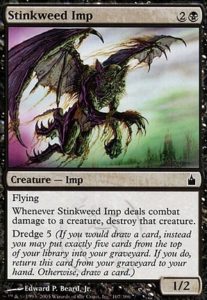
The archetype is all about, well, dredgers. It’s the most efficient way to self mill and the more cards we flip in early turns of the game, the bigger the chances for finding the duo of Narcomoeba + Prized Amalgam or Silversmote Ghoul + Creeping Chill are. The biggest power of Dredge is chaining dredgers, so if everything goes right, we never have to naturally draw cards. This means that we both decrease the chances to draw our payoff cards and increase the likelihood of flipping them to the graveyard.
Stinkweed Imp
The best Dredger we have left in the format. Outside being the highest Dredge value, it’s also a relevant creature to cast. A repetitive, quasi-deathtouch threat can stop boards all by itself, and flying lets us win trash wars during board stalls. Always play four copies, never side it out.
Golgari Thug
It’s been a necessary evil ever since Golgari Grave-Troll got banned. Most of the time it will act as a Dredge four card with no other text, but don’t forget it’s a creature with relevant ability:
- The most frequent use of the trigger is to put Narcomoeba from the graveyard back on the top of the library. It’s useful when you are in chump block mode, to present two creatures every turn (Narco and Thug). It’s also good versus control decks with sweepers, so you’ll have guaranteed Narco next turn (or even the same turn with an instant speed self mill or Dredge) to trigger Amalgams. In mid-game versus soft hate, Ox of Agonas is sometimes a decent target as well
- You can respond to Thug’s trigger. The most iconic use was targeting Bloodghast and in response using fetchland to return it to the battlefield and fizzle Thug’s trigger. It’s not that relevant nowadays though
- Remember that Thug’s trigger is not a ‘may ability’, so don’t cast it if your dredge chain is broken and you want to restore it while not having any other creatures in a graveyard to target. Without them, Thug will target himself and you’ll draw a blank instead of a possible enabler
Darkblast
On the surface, this card looks very simple. Killing opposing one drop while jump starting our chain is a great tempo swing. It gives us more turn one plays – something the deck desperately needs. Most of the time it’s used versus decks with x/1 creatures: Ragavan, Nimble Pilferer, Dragon’s Rage Channeler, Esper Sentinel, mana dorks, a Dwarf token, Inkmoth Nexus, etc. But that’s only the beginning! It can also kill creatures post-combat after our threats have dealt combat damage. The most common line is dealing with x/4 creatures after they block our three power attackers. Omnath, Locus of Creation, Endurance, Yawgmoth, Thran Physician, a Rhino token from Crashing Footfalls, Scion of Draco, Urza, Lord High Artificer, Dryad of the Ilysian Grove etc. x/2 creatures can also be picked off if you have Golgari Thug or Narcomoeba. It’s a fine way to kill Solitude for example, before they untap and gain even more life from Lifelink. Another way to kill x/2 creatures is to cast Darkblast on your upkeep, Dredge it and cast it again. Darkblast can also kill our own creatures. Killing Golgari Thug to put Narco to the top to trigger it in the next Dredge or to avoid losing to decking also can happen from time to time. It can also target Silversmote Ghoul if you flip a Creeping Chill and Prized Amalgams are waiting for something to return from the graveyard. Killing it can also protect it from exile effects. Finally, Darkblast can deny lifelink – kill your x/1 creature after blocks but before the damage.
Life from the Loam
It’s more like an honourable mention than a real card in the current Dredge build. Dakblast won a competition for the Dredge three card of choice. Casting Loam nowadays feels too slow and not impactful enough. It’s nearly always better to cast Reunion or Ox. Still, maybe one day we’ll return to the build based on this engine.
Enablers
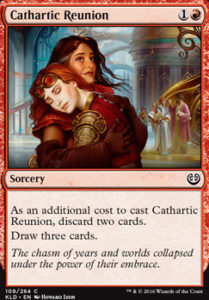
We know that keeping the Dredge chain active is important in Dredge. But we need to start the engine somehow. To make it work, we have enablers. These are the most efficient ways to put Dredgers in the graveyard and redraw as many cards as possible for the lowest mana cost. Remember – our goal is to escape Ox of Agonas on turn three. This means that Reunion on turn two should be enough to set it up – it’s three dredged cards plus another one from a natural draw. Having extra Reunions in hand is not a bad thing, but there’s a chance they won’t be used because they will be discarded thanks to Ox of Agonas – if you have the option of casting yet another Reunion or Reunion on legs that will trigger Amalgams, getting a guaranteed 5/3 on board will likely be better. That’s why we also want to use enablers on turn one, just to do something with cards in hand. Binning a dredger before the draw step on turn two gives you another opportunity to flip more stuff, Ox included. Your best hands will contain at least two lands, something to cast on turn one and Reunion. Right now, I’m playing a 6/6 split between one and two mana enablers and the goldfish timing is fine.
Tome Scour
It’s the best turn one play in goldfish scenarios. I like to call it a ‘Stinkweed Imp on a stick’. It’s simple and doesn’t require any other card to do its thing. It’s also a good way to find a dredger – if you keep a Scour + Reunion hand, mill five gives you a 79% chance to flip a dredger if you play twelve copies, 74,5% if eleven. It’s also the largest number of cards milled by any one mana spell in the format, which increases chances of getting one of the payoff duo we want to collect: Narcomoeba + Prized Amalgam or Silversmote Ghoul + Creeping Chill. Tome Scour will give you six cards in the graveyard after turn one, so if you were lucky enough to flip Stinkweed Imp or Golgari Thug and unlucky enough to not get a lot of payoff cards, there’s a chance for escaping Ox of Agonas on turn two. It’s easily the most powerful effect on turn one in goldfish scenarios.
When I started playing the card, I was not playing Tome Scour as a four-of because I was scared of how bad it is versus hate cards. But after more testing I concluded that it’s so much better in goldfish compared to Gaze that it’s worth playing it. Tome Scour gives the most looks for a dredger before you cast Reunion. The one mana enabler that can create a huge advantage before the opponent can react and stabilise our regular draws is what the deck needs. Casting Tome Scour on turn one on the play is also the best answer to discard and opponents’ one mana countermagic – if milling starts before they can play their first land in the game, the opponent often feels hopeless. And even if you are on a draw – playing Tome Scour and trying to get your opponent to expend their resources so your Reunion stick is a pretty decent line as well. It’s also solid against one-shot graveyard hate like Endurance or Tormod’s Crypt – if your one mana spell can force its activation, that usually means that you haven’t used many resources and there’s a good chance to rebuild later on with a timely Reunion. I recommend playing a full playset.
Otherworldly Gaze
Unlike Tome Scour, the card is not that powerful on its own. Gaze should be considered more as a great support card, so our good turn two Reunion opening could happen more often. Flipping dredgers is a primary thing an enabler should do. And to be honest with you – Otherworldly Gaze is not the best at doing so. For a deck with twelve dredgers, the odds of finding one is 54,5%, much lower compared to Tome Scour. The true power of the card is in what else it can accomplish. Still, it’s played mostly because there aren’t any other better options (just give me Careful Study!) I play two or three copies.
- It lets you keep good one landers. The most heartbreaking thing in Dredge was to see in the opening seven something like two Reunions, Imp, Thug, and only one land, which would be unkeepable. But with Gaze instead of one Reunion, it’s ok to use it as a scry 3 with an upside to find a second land. Coupled with the draw step, it digs four cards deep. Good one landers were keepable with Faithless Looting and Gaze digs one card deeper. Because of it, the range of playable hands has increased. It also let us go down from nineteen to eighteen lands
- It can find a Reunion in the top three (the odds aren’t the highest, but it’s better than no selection at all). It’s important in game one in goldfish scenarios, as well as post side when we are playing vs one-shot grave hate like Endurance
- It can also find a sideboard card, so you can choose to naturally draw and react to something problematic
- It’s an instant – important with Gemstone Caverns in the sideboard and with other one-mana reactive cards ready to be cast
- It does stuff from the graveyard. Maybe it’s not the best way to spend two mana, but sometimes you don’t have anything better to do anyway. At least it can restore a broken dredge chain, or prolong it, for example in response to a Narcomoeba trigger, looking for an Amalgam. It can be useful in postboard games when topdecking Reunion can give you a much needed boost after opposing graveyard hate wipes your resources
Cathartic Reunion and Thrilling Discovery
The majority of times, both cards will do the same: discard two and draw three cards, resulting in dredging up to fifteen cards in the best case scenario. The longer our dredge chain is, the easier to get an overwhelming advantage early in the game. Try to maximise the value of these cards. They are powerful, but only with a good setup. The ideal scenario is having at least two good dredgers in the graveyard (Imp and Thug counts, Darkblast should be counted as a support card) before casting Reunion. If you don’t have them, sometimes it’s better to spend a second turn on flashbacking Otherworldly Gaze to get more looks for dredgers than trying to go off from just a single Darkblast.
The number of Reunions remains an important discussion in the Dredge community. Assuming we have twelve, sometimes thirteen slots for enablers, we have to separate these slots into one and two mana cards. Eight copies was too many, mostly because hands with multiple Reunions were as good as the ones with only one because the turn-three Ox was discarding remaining copies that got stuck in hand. For some time I was playing seven, but eventually, I landed on six and based on my testing I think it’s a good number.
Which one is better, Reunion or Discovery? Let’s analyse that:
- Casting cost: Cathartic Reunion is better here because it doesn’t force you to grab a Sacred Foundry early in the game. It can be cast with Blood Moon in play, when the opponent has Spreading Seas, etc. This is the biggest reason to favour Reunion over Discovery
- Lifegain attached to Thrilling Discovery: It’s a minor addition and it helps you negate the life loss from our manabase. If you resolve two Discoveries on the same turn, they will trigger Ghouls.=
- Discarding cards as a cost versus doing it on a resolve: it doesn’t matter in goldfish scenarios, but can be a huge difference when playing versus counterspells or soft grave hate. Both outcomes are useful and there isn’t one universal solution to what should be cast first. If you are curious how to play with Reunions perfectly, check the gameplay section of the primer
Merchant of the Vale
I’m not the biggest fan of this card. Its ceiling on turn one is what Tome Scour does all the time. It’s quite bad in heavy mulligan situations when you don’t have access to the enabler + dredger sequence all that often. The creature part rarely matters in contemporary Modern. The card’s only upsides are easier casting cost and that it can be played on the opponent’s turn, so it works nicely with Gemstone Caverns. That’s why it’s played in versions with four Caverns in the maindeck (but the version is bad, so you shouldn’t add bad enablers only to justify playing it).
Options from the past
Shriekhorn
In goldfish scenarios, it’s worse than Tome Scour on turn one and our curve later on is filled with two mana plays anyway – it was better in the past because of the mana requirements, but it’s no longer an issue with the rainbow manabase. In interactive games, the flexibility of Otherworldly Gaze is more useful than just a raw flipping power. It’s a good enabler and one day maybe it will come back, but at the moment, other options are better.
Insolent Neonate
A card from the past. Similar to Merchant of the Vale, but can’t be cast at instant speed. Don’t play it!
Burning Inquiry
Another card from the past. Since the discard is random, it doesn’t guarantee to bin a dredger, so it shouldn’t be considered a turn one play. And after turn one, we want to cast Reunions. It was bad even in 2016, so you can imagine how bad it is now.
Payoff

Milling cards is fun, but it’s easy to forget that we are doing it to set up the early pressure and overwhelm the opponent before they can do anything about it. What is used to finish the opponent?
Ox of Agonas
Payoff creature which also acts as an enabler that works from the graveyard. The fact that it combines both roles makes it the best option available for Dredge nowadays, even if we have to pay mana for recurring it and build the whole gameplan around Ox to support it. You can set it up as early as turn two, with the help of Tome Scour. Most often, it will be available for you on turn three and later on. And once you resolve it, you’ll most likely find a second one and be close to milling your entire library on turn four. If you have a choice between escaping Ox, or doing something else, usually, you should go for the 5/3. Don’t be afraid to exile potentially useful stuff from the graveyard – you’ll most likely flip more of it from Ox’s trigger. I wouldn’t go for it only if the opponent represents countermagic and escaping it would mean that I would lose the tempo and payoff cards. Watch out for Subtlety and Tishana’s Tidebinder as well. Otherwise, just go for it. Don’t forget that you can cast Ox from hand! It can sometimes happen postboard in slower match ups, especially when soft grave hate is involved.
Narcomoeba
Dredge staple from the beginning of the archetype’s existence. By itself, it’s quite bad – 1/1 flyer isn’t spectacular, even if it’s ‘free’ – that’s why most lists run three, not four copies. It’s in the deck only because it’s the only way to return Prized Amalgam without any further restrictions.
Remember that you can choose if you want to return Narcomoeba from the graveyard or not. Sometimes it’s better to keep it in the graveyard. For example, having it in the graveyard can be more important to fuel Ox of Agonas and its Escape ability than to have a 1/1 flyer on board. Furthermore, there are some situations where you don’t want to trigger Prized Amalgam, for instance if you want to play around Anger of the Gods or any other sweeper and you have Silversmote Ghoul/another Amalgam triggered to return in your end step.
Prized Amalgam
It was the first real reason to play Dredge in Modern. After all these years, it’s still great. The whole deck is built in a way that makes it relatively easy to return all flipped Amalgams by turn two or three. The timing of the return of Prized Amalgam is quite tricky – it returns at the beginning of the next end step. So if it gets triggered at your end step (for example with Silversmote Ghoul), it won’t be able to return right away, because it will happen after the beginning of the phase. Amalgam will wait for the next possible moment, which will be at the opponent’s end step. We can use this effect to play around sorcery speed mass removal like Supreme Verdict, Ugin, the Spirit Dragon or Anger of the Gods.
Remember that Amalgam’s ability isn’t a ‘may’ ability, so once triggered, it has to be returned to the battlefield.
Creeping Chill
Another ‘free’ effect we get from Dredging. Great in tempo games, when hitting a couple of Lightning Helixes can win the game by itself. It’s also a crucial part of the ‘burn’ plan when combat damage is not enough to close out the game on time. In my opinion, this card is a reason that keeps Dredge head above water. In the current version of Dredge it’s even more important than in previous ones because it’s also used as a way to trigger one of our payoff creatures – Silversmote Ghoul.
Like Narcomoeba, its triggered ability is not mandatory, so you can choose to not use it. This will come in handy when you need fuel for the Escape or the opponent has two Death’s Shadows and you don’t want them to grow.
Silversmote Ghoul
When combined with Creeping Chill, it’s able to return for zero mana and any other further restrictions. In longer chains, it acts as a Narcomoeba/Prized Amalgam hybrid – can both trigger our 3/3 and it’s a somewhat threatening body on its own. One toughness can be problematic against cards like Orcish Bowmasters, Fire//Ice, Wrenn and Six, etc., but this is what we’re working with in Modern. Silversmote Ghoul got a lot of power when Dredge became more of an all-in strategy. More Reunions means longer Dredge chains in early turns of the game, so it’s also easier to see Chill + Ghoul on the same turn. To maximise the odds of finding one when Creeping Chill got flipped, it’s played in the full playset.
Ghoul returns in your end step, so if you want to try to flip it and Chill from Otherworldly Gaze, do it in your turn. Note that it’s not a ‘may’ ability. The lifegain doesn’t have to be from the Creeping Chill. Opposing Solitudes on your turn (but before the end step) that exiles our Amalgam or Ox will trigger it as well. The last tip: remember about Ghoul’s second ability! It’s good in tempo scenarios when we pressure the opponent with 3/1s and they have to waste removal spells to survive. You can also use it to find your last Creeping Chill to deal the last points of damage. Or sacrifice it if you’ve just flipped Creeping Chill, but you lack something that will trigger your Amalgams. Stay open minded.
Options from the past
Bloodghast
Another honourable mention in the primer. It used to be the best, but also the most skill-intensive payoff creature Dredge had, but the card lost a lot of its power with the ban of Faithless Looting. Nowadays, enablers cost more mana on average, so it’s harder to cast them before making the land drop. Maybe one day it will return.
Conflagrate
In the Loam Dredge era, Conflagrate was like a swiss army knife. It was a great removal spell, could act like a huge Fireball to finish the opponent, a discard outlet and even a removal for your own Bloodghasts, so they can be returned with a land drop, so you could trigger Prized Amalgams. But Modern has changed, and so has Dredge. Conflagrate nowadays shows only a fracture of its power compared to the Loam times. The card clashes with Ox of Agonas, which is our go-to payoff. There aren’t as many cheap creatures to kill that won’t die to Darkblast already (mainly Ragavan, DRC, and mana dorks). It’s not as backbreaking as many of you think it is versus Yawgmoth due to Undying creatures and Wall of Roots. It’s not that effective against Hammer since they can cast and equip Hammer on the same turn, so our sorcery speed removal won’t do much. It’s also hard to catch Bowmasters because it has Flash. The only real upside of the card is that it enables the burn gameplan – Conflagrate combined with Creeping Chills can kill the opponent even without a single point of combat damage. It can also act as another needed source of damage for turn three kills if your early flips were fortunate enough. Discarding cards as a cost, not as a part of resolving the spell can also be useful against countermagic. Because Darkblast isn’t as good as it was, I decided to cut the fourth one and add one Conflagrate to have a creatureless route to victory and I side it out if the burn plan isn’t good in a matchup.
The manabase
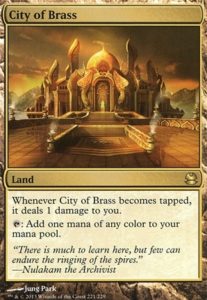
Dredge has somewhat demanding mana costs. It’s an aggro-combo deck, so every land has to enter the battlefield untapped. It’s basically a mono-red deck with three (or sometimes even four) splashes. All lands need to produce red, mostly because of Ox of Agonas. Having only two lands happens too often to have even a slight chance of not having the mana for that. Outside red, every other colour is important. Blue is used for Otherworldly Gaze and Tome Scour, white for Discoveries and sideboard options, black to cast dredgers and discard spells postboard. Green is the least important since it’s only sometimes used only for Ancient Grudge flashback.
Fetch + shock manabase was a core of Dredge since the beginning of its existence. But the deck started to be so greedy on the mana that going with traditional mana builds wasn’t enough. Every land must produce red mana. In terms of splashes: we now need Blue on turn one for our enablers, but also sometimes black if we want to cast Darkblast or discard spells from the sideboard, or white if Portable Hole is needed. There’s also a need to white on turn two, thanks to Thrilling Discovery. If you also consider that you often work only on two lands, you’ll quickly find out that relying only on fetch + shock manabase won’t give you access to all colours on time. That’s why rainbow lands – City of Brass and Mana Confluence – were added. Having even one in the opening hand solves all mana problems. At first, this take was abused a bit too hard and a build of 12x rainbow (with four Gemstone Mines) + six fastlands was the most played one. To be honest, I was the one who popularised it. The main idea was to negate the life loss of rainbow painlands by adding fastlands to the mix. There were two problems though. The first one was Gemstone Mine. Having two of them in the opening was leading to awkward moments when you were losing to sacrificing your own lands. It was also the easiest way to lose games against decks with counterspells – otherwise a very good matchup for us. The second problem was in mana sources of less needed colours. It was possible to build a manabase that would support blue mana nicely (twelve rainbow + three Spirebluff Canal), but black and white had to be ignored a bit in the process. And in some postboard games, for example white was more important because you had to resolve Portable Hole or Wear//Tear to answer the opponent’s hate cards. That’s why I eventually switched back to eight rainbow lands and a small package of fetches and shocks. Now I’m playing the 6/4 split and I’m happy about it.
Some of you were asking me if it’s possible to build the manabase without Mana Confluences for budget reasons. You can try to cut it and play those lands instead: 1 Gemstone Mine (the first one is acceptable, but sucks in multiples), 1 Spirebluff Canal and 2 additional fetchlands. The deck would be slightly worse, especially if you plan to cast white cards from the sideboard often, but it will still do the job.
The most interesting decision in building the manabase was the mix of shocklands. Playing only one Sacred Foundry is self-explanatory. Outside that, I wanted to play three more fetchables (so I’ll get a decent chance to have something to find after milling a bunch of cards), but I didn’t know which one should be played in multiples. I eventually decided to play two Blood Crypts and only one Steam Vents mostly because I wanted to have more consistent access to the only non-red play that can bottleneck me on mana – double Darkblast. Also, the timing of the spells I cast matters a lot. Both of my blue enablers (Tome Scour and Gaze) cost one mana, so I often fetch Steam Vents first. So there was no need to play more than one if the first fetch secured blue. That’s why I play two Blood Crypts to decrease the chances that due to casting the one mana enabler and dredging on turn two, I mill all of my fetchable black sources.
Gemstone Caverns in the maindeck – is it worth playing?
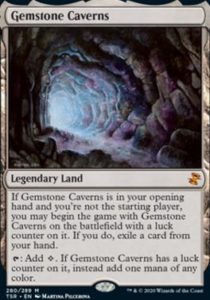
As you can see above, I presented the typical manabase without any Gemstone Caverns. There are Dredge players who would disagree with me. You can find decklists with four copies in the maindeck. The idea is to always go second, even if you win the die roll. It gives you an additional card all the time while technically being on the ‘play’ a bit below 40% of the time, so it should slightly decrease the fail rate. While it looks cool and you feel invincible when it works, I’m not a fan of this idea at all. In my opinion, being on the play is more important for the tempo deck than an extra card in hand. There are also other downsides, for example drawing two Gemstone Caverns as your only lands, finding it after you kept one lander with Otherworldly Gaze, etc. In my opinion, Gemstone Caverns is a really good sideboard option that comes in only if you are on the draw.
Sideboard options
Dredge sideboard is nothing special in the combo world, as its main use is to neutralise opponents’ hate cards. The secondary purpose is to do what regular sideboard cards should do – answer opponents’ key cards or strategies, but it’s less important than their primary application.
When building and using your sideboard in Dredge, it’s also important to understand how sideboarding affects the deck’s main gameplan. Dredge is an aggro-combo deck that’s designed to get a critical mass of threats early in the game. It’s also so dedicated to its main gameplan that we can’t pivot into something different after game one. We are simply forced to execute the same plan over and over again. That’s why our sideboard should always prioritise answering the opponent’s hate cards. If you feel that the hate is covered, or you can just overpower it with what you have in the maindeck, then you can start thinking about hating the opponent’s strategy. There’s also a huge threat of oversideboarding. In my opinion, in Dredge, it’s better to not bring in something that might be good, but you are not 100% sure about it than to add something that’s not absolutely necessary. Sure, sometimes you’ll lose to a random Leyline of the Void that somehow got into the sideboard of the deck that usually doesn’t play it. But the fear of it shouldn’t force you to always side in three Wear//Tears. In the long run, you’ll lose more games to overboarding than to an unanswered hate card that isn’t usually present in your opponent’s archetype.
Because Dredge is so focused on its own gameplan and its curve is filled with plays (for those who haven’t read the first part of the primer: turn two Reunion, turn three Ox is the goal) answers have to be as cheap as possible so they won’t slow down our goldfish time too much. They also shouldn’t require you to keep the mana open at all times. Cards like Spell Pierce or Flusterstorm may look decent in theory, but in practice, you’ll always want to develop your gameplan and tap out for an enabler instead. They also work terribly with Ox of Agonas. Playing something that stays on the battlefield or has an impact immediately is a better approach. The ideal example is Leyline of Sanctity – it costs zero mana, so if we have it, we won’t lose any tempo at all and will be able to deploy our threats while being protected from various graveyard hate options. Sadly, nearly every other answer costs some amount of mana, so you can expect to be slowed down due to them. Still, you should prioritise the cheapest ones. Mainly because they can be cast on the first turn, before our earliest opportunity to cast a Reunion effect, and secondly because of the possibility of a turn three one mana card + Reunion sequence.
Top options for Dredge sideboard
Dredge is in a good place in terms of possible additions – thanks to being a rainbow deck, we can choose the best options for the deck and not think too much about colour requirements. Deckbuilding restrictions also aren’t that much of a problem.
Gemstone Caverns
A unique card that deserves to have a separate segment. It’s an old tech that got a second life thanks to deckbuilding changes that have been made after MH2. Side it in when you are on a draw, as simple as that. This card isn’t widely played because it has a lot of restrictions attached to it. You can’t focus on card advantage and have a good way to use your extra mana early in the game, so the opponent won’t be able to keep up. Luckily for us, Dredge can make it work:
- Dredge is one of the few decks in current Modern that doesn’t care how many cards are in your opening hand. As long as you have two lands and any way to start the engine, you should be fine. Starting with five or four cards is a common thing. That’s why it’s a good trade for us to exile one card from our hand to get the tempo advantage when we are on a draw
- Since Gemstone Caverns enters the battlefield before the game starts and the first turn in the game is the opponent’s, it’s important to have enablers that will fully benefit from the fact we have this one extra mana source on the turn ‘zero’. Loam Dredge didn’t have any meaningful options. Nowadays, we have Otherworldly Gaze, Darkblast and Reunions that can overwhelm the opponent when played on turn one
- Dredge nowadays greatly benefits from the Gemstone Caverns with a luck counter. Having it smooths the mana significantly
There’s one more requirement that makes this card good in some decks. If the deck can handle playing a colourless land with no upside to get potential benefits while on the draw, then Gemstone Caverns can be maindeckable. Archetypes like Rhinos, Calibrated Blast or Prison Tron are good examples of that. They don’t have to go all in and let the opponent start the game even if a die roll was won. Sadly, Dredge is not one of those decks – a land that doesn’t produce red mana isn’t acceptable. That’s why I recommend playing it only in the sideboard, so you’ll have access to it only when you are on the draw.
Cards that protect our gameplan
Your sideboard should be able to deal with the most commonly played types of hate. Ideally, you should have something that covers one-shot artifact hate (Relic of Progenitus, Tormod’s Crypt, etc.), the interaction that’s hidden in the opponent’s hand (Endurance, countermagic, etc.), other problematic permanents (Dauthi Voidwalker, Sanctifier en-Vec), and sometimes enchantment with static abilities (Leyline of the Void or Rest in Peace). I’m sure you’ll be able to find the best possible answer for each of these problems. The trick is how to pack everything into fifteen cards and have enough copies of a needed card to draw it often enough to matter. The solution is to play wide answers that will cover many different types of hate. For example, Thoughtseize can deal with both Endurance and Spell Pierce, while also being an out to Rest in Peace or Sanctifier en-Vec if the opponent has them and we are short on more dedicated answers.
Portable Hole
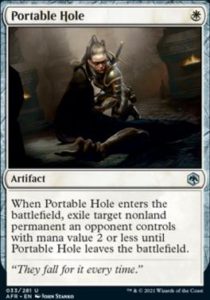
It’s the best catch-all answer we have access to. It can deal with nearly all of the permanent-based hate cards we care about: Dauthi Voidwalker, Unlicensed Hearse, Rest in Peace, Sanctifier en-Vec, Grafdigger’s Cage, and one-shot effects like Relic of Progenitus, Tormod’s Crypt, etc. The biggest upside compared to other, more specific answers is that it’s rarely a dead card. If the opponent doesn’t have hate, it’s quite likely you’ll find another relevant target – a mana dork, Ragavan, opponent’s engine cards, etc. The flexibility of what can be exiled with it is a strong reason to play it, but the most important one is that it costs only one mana. Like I said many times – having a good mana curve in Dredge is very important. It would be even better if it had Flash, but we can’t have everything. In practice, casting Portable Hole will sometimes cost you some tempo, but at least not in every scenario. Turn two Hole + Otherworldly Gaze/Tome Scour or turn three Hole + Reunion are the lines you should be looking for. This type of double spelling is something that the previously played alternative to Hole, Prismatic Ending, couldn’t do.
Sorcery speed is not its only problem though – Portable Hole stays on the battlefield, so it can be destroyed later on. That’s why if you expect to play against decks with a lot of ways to remove artifacts (Boseiju, Leyline Binding) or with both Teferi, Time Raveler and Rest in Peace, then maybe playing Prismatic Ending and paying more mana, but dealing with the hate for good is a better thing to do. But overall, most of the time I would choose a cheaper answer.
Wear//Tear
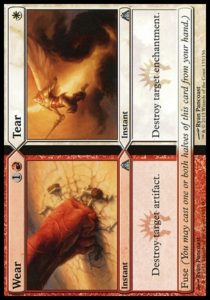
Wear//Tear has one role in Dredge sideboard – to destroy enchantments, mainly Leyline of the Void. In the past, Nature’s Claim was played in this slot. Wear//Tear won the competition because current Dredge lists have more white than green mana sources. Giving four life to the opponent is also more problematic than it was in the past, since the deck is more tempo-oriented than it used to be. If you expect black Leyline to be somewhat popular in your metagame, I recommend having at least three copies of Wear//Tear, just for it. The biggest problem is how to predict when it’s the time to be prepared and when you can ignore the problem and add other useful cards instead. There aren’t any golden rules for this – just analyse the metagame and, if other graveyard decks aren’t too popular, there’s a chance people will ignore those strategies a bit. If you feel that they aren’t on people’s radar, feel free to cut Wear//Tears.
There are also other targets than just Leyline. Urza’s Saga is a big one. Sigarda’s Aid and Dryad of the Ilysian Grove are often important to deal with as well. Wear//Tear can also deal with artifacts, but you shouldn’t consider it as a go-to response to cards like Relic of Progenitus or Unlicensed Hearse. Paying two mana for an answer is not where you want to be. Still, sometimes casting Wear will be correct, so keep in mind you can do it. Don’t forget about the ultimate value option of Fuse. Using this mode can happen quite often versus artifact-based Urza’s Saga decks like Affinity or Hammer.
Lightning Axe
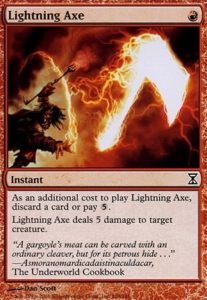
It’s the best removal spell Dredge has access to. It’s good at dealing with hatebears and regular creatures that threaten to tempo us out. Lightning Axe is so good in Dredge because it also acts as an enabler – as long as the opponent gives us a target of course. The ability to play it in the upkeep means that it can restore the broken Dredge chain before the draw step. It can also enable tricks with discarding in response to triggers on the stack. Lightning Axe does not see as much play as before MH2 because there aren’t that many decks with cheap creatures we want to kill. And against currently played creature decks, either other sideboard cards are more important or their creatures are x/1, so they can be killed with Darkblast. The effect is powerful though and shines in certain metagames, for example with a lot of Murktide, Prowess, and other heavy-creature decks.
Thoughtseize
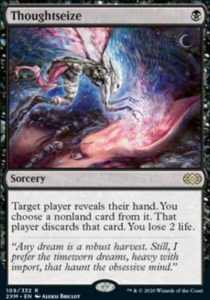
A solid catch-all answer to most of the things you can encounter. It’s good against every form of hate that hides in the opponent’s hand – Endurance is a great example of that. Discarding cheap counterspells like Flusterstorm or Spell Pierce or at least forcing the opponent to use them, so our turn two Reunion could resolve is a powerful move as well. It’s also a reasonable answer to otherwise game-ending hate effects like Dauthi Voidwalker, or white exile effects – Sanctifier en-Vec and Rest in Peace. In fact, it’s the best possible answer to them since it prevents us from losing what we already had in the graveyard.
The biggest upside of discard is how nicely it fits our curve. Starting from turn two we ideally want to play our enablers, so having a way to get rid of the opponent’s hate card on turn one is huge. What’s even better, it never truly misses. If the opponent doesn’t have a hate card, you can just grab their best card and slow them down. This plan is used against combo decks when Dredge’s best chance to win is to have a turn one Thoughtseize into a good flip from turn two Reunion. If you are worried about your life total and want to play discard anyway (for example against Sancifier en-Vec in Burn), you can play 1-2 copies of Inquisition of Kozilek instead. Just don’t go too hard on it because cards like Primeval Titan, Yawgmoth, Solitude, and other more expensive cards still need to be answered.
When should you have Thoughtseize in your sideboard? In my opinion, it’s correlated with the popularity of Endurance. If it’s played everywhere, I opt to rely more on Leyline of Sanctity. But if opponents’ hate is more diversified or there are just enough decks with spell-based hate or gameplan (Creativity and UW Control are good examples), I’m more into playing discard.
Leyline of Sanctity
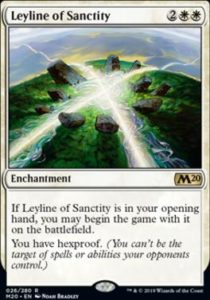
In my opinion, it’s the best solution if the metagame is infested with Endurances. Otherwise, I would choose Thoughtseize over it. The card has a few upsides:
- It costs zero mana. It’s the only option that doesn’t affect our goldfish time
- It requires the opponent to side in answers not only to the graveyard, but also to enchantments, or at least change the sideboard plan. This means that the mere possibility of Leyline in our opening hand forces the opponent to make suboptimal decisions
- It stops not only one, but all Endurances your opponent can have
- It can randomly stop other decks like Burn or Belcher from executing their gameplan
The card has weaknesses too, a lot of them to be honest with you. I listed them below:
- You must have it in the opening hand to make it work. Luckily for us, Dredge doesn’t draw many cards anyway, so the chances to draw it as a dead card are smaller compared to other decks in the format. Even if it happens, Dredge doesn’t care that much about card quality – all that matters is whether the engine is going
- If it gets answered, all the Endurances the opponent had in hand will once again be active, so the blowout potential is quite high
- Wizards printed a lot of cards that instead of targeting an opponent, so that Leyline could stop it, had the dreaded ‘each opponent’ annotation instead.
Ancient Grudge
The effect may not look that great, but what matters is its flashback ability – the fact it works from the graveyard makes it extremely powerful. It’s one of the very few sideboard options that works well with our main gameplan, which makes it much more accessible than the cards you actually have to draw. It usually forces the activation of hate cards like Relic or Tormod’s Crypt. It’s also a fine way to deal with Unlicensed Hearse. In some matchups, it can be used to attack the opponent’s gameplan rather than their hate. Against Hammer for example, destroying Shadowspear is often a game-winning move. Dealing with an Ensnaring Bridge, Amulet of Vigor, Aether Vial, etc. is a nice bonus.
The biggest problem of Ancient Grudge is its flashback casting cost. The deck in its current form is already extremely stretched in terms of coloured mana – heavy on red with three splashes. It’s all good when you draw one of your eight rainbow lands. The problems start when you have to rely on shocklands and fetchlands. The deck often works only on two lands and all other colours are more needed than green. Stomping Ground in game one will be a worse Mountain and we can’t afford to even play a basic because there’s a need for multicoloured sources. Green will be used only postboard, when Grudges are sided in and that’s why I concluded that if I want to have Ancient Grudges in the sideboard, I should add Stomping Ground to the sideboard as well and bring them together. Some would say that it’s a waste of slots, but in my opinion, having much better mana in every single game you play is worth it. Still, the cost in terms of occupied sideboard slots is big and I recommend going for Ancient Grudge + Stomping Ground only if you expect to see a lot of artifact decks, mainly Hammer – it should give you a lot of percentage points in the matchup.
Ray of Revelation
Ancient Grudge for enchantments. It looks good in theory, but in practice, there aren’t enough good targets for it. What’s more important, the most problematic enchantment played (Leyline of the Void) prevents us from flashing it back. It’s also quite hard to catch Rest in Peace with it – this would require having Ray in the graveyard and keeping green mana up, so you could answer RIP’s trigger. And of course, there’s a problem with access to green mana. Because of these reasons I rarely play this card and I use it only if I expect to see a lot of enchantments (for example different Urza’s Saga decks).
Cards that attack opponents’ strategies
Sometimes we have the luxury of playing sideboard cards that are used to stop what opponents are trying to do. Because we don’t usually have more than four slots for them, they are filled with powerful cards that can end the game by themselves. Remember that you are not forced to play three or four copies of the same card. Going for a bunch of one-ofs can also be quite effective in Dredge. This route will give you two different advantages. The first one is an obvious one – sometimes you’ll be lucky enough to have it in the opening hand and win before the game starts. The second advantage is less straightforward – sideboard cards will often provide some value even if you only mill them while dredging. The opponent won’t know if you play a single copy of it or a full playset, so they will have to respect it anyway. Showing the opponent that you have access to a powerful hate card that requires a very specific action from the opponent will force them to sideboard in an unusual way. As a result, for game three, the opponent presents a worse version of their deck, with some most likely dead cards to stop your lucky one-of.
Let’s check useful options:
Leyline of the Void
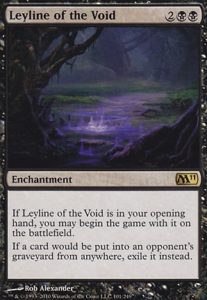
Very narrow but powerful response to other graveyard decks. The less expected it is, the better it works. If the opponent knows that you have it, they can side in answers or change the plan (for instance Murktide players can side out Murktides, DRCs and rely more on Ragavan, Ledger Shredders and planeswalkers). There’s also one more problem – if both you and your opponent have Leyline of the Void in the opening, Dredge is still disadvantaged. We are the most graveyard-centric deck in the format and if we can’t abuse it, our cards are quite bad on their own. So for example, if you and your Living End opponent each have your hate, you are more likely to lose. That’s why I first think about answers to the opponents’ hate and then maybe add Leylines to the mix if I have free slots to do so. I tend to play Leylines when other graveyard decks are not interested in playing it. The sweet spot is to have at least one since the first Leyline is the best Leyline.
Chalice of the Void
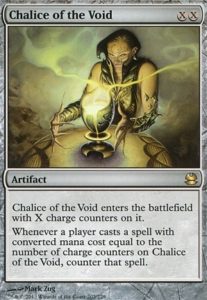
The main idea is to play Chalice of the Void for zero. It’s good versus Cascade decks, Underworld Breach (without the ability to cast zero cmc spells over and over, they can’t mill themselves and cast Thassa’s Oracle for the win), and to some extent Amulet (Chalice counters Summoner’s Pact). This line of attack is especially good in Dredge because it doesn’t interfere with our mana curve. Chalice can also be good on the play versus decks that heavily rely on one drops, for example Hammer. Sure, it will counter our Darkblasts and Gazes, but the opponent should suffer more. Still, it’s more of a cheese than a real strategy in a match up.
Pithing Needle
The card is both good at stopping some graveyard hate cards and problematic combo pieces or planeswalkers. While you can name Relic of Progenitus or Nihil Spellbomb, I don’t recommend siding Needle in the blind versus decks that don’t have other relevant cards to name. It’s a viable addition against strategies that both have grave hate with activated abilities and rely on planeswalkers or activated abilities of other nonland permanents. Tron with Relics and Karn, the Great Creator would be a good example. It’s also good at stopping random combo decks: Yawgmoth, Belcher, Oops, Underworld Breach etc.
Conflagrate
I can imagine some weird, tribal-centric metagames when I would like to play a copy in the sideboard instead of the one in the maindeck.
Path to Exile
If having a one-mana instant speed hard removal is decent in your meta, Path is the best option available.
Deafening Silence
Quite a narrow, but very powerful way to stop storm-style combo decks. Being for one mana is relevant for the mana curve. That’s a game changer compared to other options like Damping Sphere. Good versus random low tier combos: Neobrand, Storm, Ad Nauseam, Underworld Breach, Belcher, etc. Sadly not that good versus Cascade decks due to Shardless Agent being a creature.
Alpine Moon
The cheapest way to hose all big mana strategies. It’s alright versus Tron and is a beast against Urza’s Saga. I can see it being playable in some weird metagames, but usually, it’s not worth wasting slots for this while sideboarding.
Force of Despair
A narrow option to wipe the opponent’s board when they don’t expect this type of effect at all. It’s considered playable because of how good it works with Dredgers – at first, you get one from your graveyard to hand and then use it as fuel for Force. What’s also important, we want to cast it after we cast Reunion, so losing a black card won’t be a huge deal (unlike in the case of Grief, when we want to cast discard before we go for the first Reunion). I can see it being good versus Amulet and maybe against Living End, but it will work only once and it’s possible to play around it to make it not impactful at all.
Subtlety and Force of Negation
With Tome Scour and Gaze in the deck, Dredge has enough blue cards to support blue pitch spells. They have their moments, especially if the opponent isn’t prepared for them, but they both have one huge problem – they work terribly with our main engine in Ox of Agonas. You can toy with them when your metagame shifts in different directions where they can shine.
